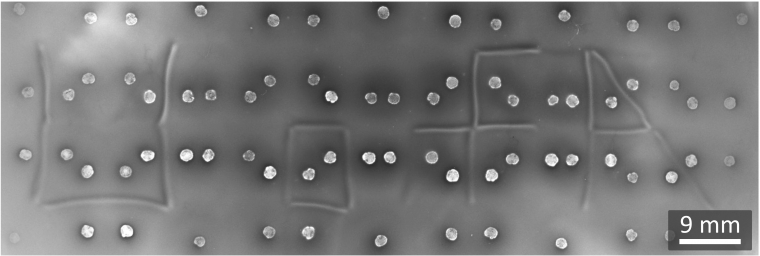More Than Meets The Eye: How Patterns In Nature Arise
University of Arizona-led research sheds light on how a certain kind of pattern in nature arises.
 Researchers think they have an idea of how tiling patterns in nature, like what you see on a giraffe's coat, came to be. Nature is full of patterns. Among them are tiling patterns, which mimic what you'd see on a tiled bathroom floor, characterized by both tiles and interfaces – such as grout – in between. In nature, a giraffe's coloring is an example of a tiling pattern. But what makes these natural patterns form?
Researchers think they have an idea of how tiling patterns in nature, like what you see on a giraffe's coat, came to be. Nature is full of patterns. Among them are tiling patterns, which mimic what you'd see on a tiled bathroom floor, characterized by both tiles and interfaces – such as grout – in between. In nature, a giraffe's coloring is an example of a tiling pattern. But what makes these natural patterns form?
A new University of Arizona study uses bacteria to understand how tiles and interfaces come to be. The findings have implications for understanding how complex, multicellular life might have evolved on Earth and how new biomaterials might be created from biological sources.
In many biological systems, tiling patterns are functionally important. For example, a fly's wings have tiles and interfaces. Veins, which provide stability and contain nerves, are interfaces, which break up a wing into smaller tiles. And in humans, the retina at the back of the inner eye contains cells that are arranged like a mosaic of tiles to process what's in our field of view.
A great deal of research has looked at how such patterns can be established through biochemical interactions. However, patterns can also be established through mechanical interactions. That process is not as well understood.
 Ingmar Riedel-Kruse
Ingmar Riedel-Kruse
A new paper published in Nature shines new light on mechanical pattern formation. It was led by former UArizona postdoctoral fellow Honesty Kim. Ingmar Riedel-Kruse, an associate professor in the UArizona Department of Molecular and Cellular Biology, is the paper's senior author.
The Riedel-Kruse lab, in partnership with researchers from the Massachusetts Institute of Technology's Applied Mathematics Department, used bacteria to model how tiling patterns can arise through mechanical interactions.
The team developed various adhesive, or sticky, molecules that were placed on the surface of bacterial cells, allowing for different cell types to selectively stick together. When these altered bacteria were then placed on a petri dish, the bacteria started growing toward each other. Whenever two different bacterial types met, an interface was either formed or not, depending on whether their surface adhesion molecules were complementary or not. Interfaces were typically half a millimeter wide and three to 10 millimeters long, containing millions of bacteria. Many such interfaces then resulted in a variety of complex tiling patterns – depending on the initial bacterial placements on the petri dish.
The authors then investigated what types of tiling patterns could be generated, and whether an underlying logic exists. They found that just four different adhesive molecules are sufficient to make any possible tiling pattern. Tiling patterns might vary in shape, size and position of the interfaces.
"We proved this mathematically with the famous four-color map theorem, which states that no more than four colors are needed to make sure that any two touching countries on a political map do not have the same color," Riedel-Kruse said.
The researchers generated many different patterns this way, including one that used interfaces to spell out "U of A" for the University of Arizona.
 Researchers used bacteria to simulate how patterns in nature arise. They were able to manipulate how bacterial grew and stuck together to write out "U of A" for the University of Arizona.Ingmar Riedel-Kruse
Researchers used bacteria to simulate how patterns in nature arise. They were able to manipulate how bacterial grew and stuck together to write out "U of A" for the University of Arizona.Ingmar Riedel-Kruse
The ideas proposed by the paper may ultimately lead to practical applications.
Scientists could create patterned biomaterials – which are made from living things and could degrade faster than synthetic materials such as plastic – with desired properties. For example, they could create a material with a specific pattern that could control how easily liquid flows over the material's surface.
"Using the logic of this research, the shape, structure, elasticity and even how fluid responds – going into the material or getting repelled – can be controlled," Riedel-Kruse said. "Or consider microbial bio factories for producing drugs and other chemicals. We could control where different bacteria are placed relative to each other to execute different parts of a complex reaction."
The fact that only four adhesions are required to create virtually all possible tiling patterns also provides new perspectives on how complex multicellular life might have evolved on Earth from single-celled life.
"The finding that four different adhesions are all that it takes to create highly diverse tiling patterns of life suggests that once sufficiently many adhesive components were available, developmental biology could generate many new forms," Riedel-Kruse said.
Publication: Honesty Kim, et al., 4-bit adhesion logic enables universal multicellular interface patterning, Nature (2023). DOI: 10.1038/s41586-022-04944-2
Original Story Source: University of Arizona

 Alerts Sign-up
Alerts Sign-up